Part 3: Three bedding retailers discuss eco-friendly retailing and consumer health concerns. Also how “green” are the new green foams?
Furniture Trends by Janet Holt-Johnstone
“Have something to say? We want to hear. Email The Prez at the prez@greenfeet.com and let her know what’s on your mind.” Do that, any time, and you’ll reach Valerie Reddeman, The President of, you guessed it! Greenfeet. When we asked her to define her business she said, “We’re eco-friendly retailers specializing in goods for the home, your yard, yourself. Everything, absolutely everything, is either sustainable or recycled. We strive to minimize our footprint!”
You have probably also guessed that Val is a live wire. Greenfeet is celebrating its tenth anniversary this year. The location, two hours north of Sacramento, “the top of the valley” at the city of Chico. With about 100,000 people, Chico is a college town. Both the city and its population have “amazing energy”, said Val. Chico lies in the shadow of the Sierra Nevada, and its agricultural sector provides 90 percent of the state’s rice crop. It is the hub of organic food companies, and olives, kiwis, peaches, strawberries, walnuts and almonds (and other good things) are important local crops.
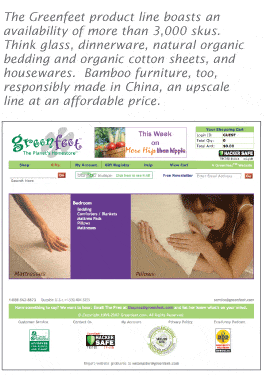
Establishing a sustainable business was not easy a decade ago but, “in the last couple of years, people have been getting the message. They have real concerns. We suggest to our customers that we approach problems one step at a time, set priorities and handle things in a practical manner for everyone’s lifestyle.
“And we’re hoping to change the bad concept that this is a disposable society, and replace it with the good concept that it‘s possible to build to last. We are trying to educate people that you can buy less, but of better quality, and that quality can be affordable. One small green step at a time.”
In keeping with our brave new technological world, Greenfeet has “exploded on line!” And now, in its eleventh year, it has expanded to a brand new warehouse. But kindly note, ladies and gentlemen, Greenfeet has no storefront at all now. A decision was made a few months ago, Val told us, to conduct her rapidly growing business entirely on line. “Although we do, of course, continue with local pickups for our customers’ convenience.
“We shop literally all over the world and we’re trying to be a force for change, for example, encouraging our vendors to pay Chinese workers fairly.” The Greenfeet product line boasts an availability of more than 3,000 skus. Think glass, dinnerware, natural organic bedding and organic cotton sheets, and housewares. Bamboo furniture, too, responsibly made in China, an upscale line at an affordable price. And gorgeous eucalyptus outdoor furniture. “We’re enlarging our horizons in this area during 2007.”
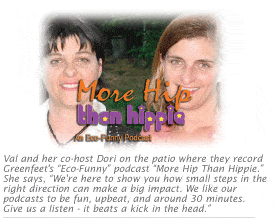
And, very important to Greenfeet folk, are Vivetique’s organic bedding products. Val says that Greenfeet sells mattresses, pillows and top of bed items, fabricated from the purest and cleanest natural fibres of the highest quality. Cotton goods are made only from unbleached, un-dyed and certified organic cotton fibres, that the “EcoDream” mattress they carry contains two types of natural latex for support and comfort, and their crib mattresses would thrill any eco-conscious parent.
There’s enamelware from Austria, a 200-year-old company, solid steel base with beautiful colours, powder blue, rose, chili red. You’ll find home décor items, folksy hand made honey pots, and natural biodegradable cleaning products. And wonderful, imaginative fair-trade jewellery from villages all over the world. Look at this extraordinary collection at www.greenfeet.com.
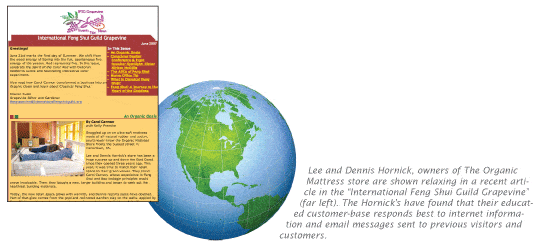
“Our active demographic is a gathering of people with the right mindset from age 16 up, to people in their 70s. They are primarily female, looking for greener, healthier attitudes. It’s a more educated crowd. And their budgets range from limited to well off.”
Greenfeet is a community fundraiser. “People here feel very strongly about this region and its needs because a lot of Federal funding has been cut.” They really “get involved. I’ve spoken at a lot of different groups and organizations, Eco-Fest and the Sustainability Conference, for example.”
There’s another way to be in touch with Val and Greenfeet. Try www.morehipthanhippy.com. Val is the host of an energetic “radio show on demand, an Eco-Funny Podcast”, complete with a listeners’ forum and many other features. “We’ll show you how to be more sustainable and earth-friendly without sacrificing convenience, style and affordability,” she says. And she does! Just listen in. “It’s our second anniversary on air/on line!”
She is positive that, “The future is very exciting, very bright. We’re investigating a lot of different avenues. There is great growth on the web. The new warehouse will allow us to be more efficient in shipping. Things are humming along nicely. We’ve had products featured recently in Gourmet, Real Simple, Natural Health and Good Housekeeping and soon we’ll be on American Shopper on Fine Living Television. Life is good!”
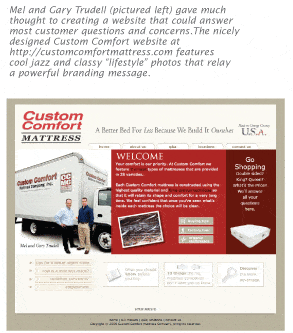
New entrepreneurs, she advises, “Must have enormous amounts of persistence and drive, must do their homework and must be passionate!” Right on, Val.
ORGANIC MATTRESS
Across the country at Hellertown, Pennsylvania, a bit south of Bethlehem, Lee and Dennis Hornick have just moved into a brand new store. Their devotion to “green” has evolved gradually over the past 20 years, “A combination of a lot of things, becoming more and more organic,” said Lee. “We once had a small organic tree farm. Shade and ornamental trees and we grew them with no pesticides nor herbicides.” Certainly green thinking.
The couple has lived and worked in Oregon, then for a time, the Cays. Lee has “been in retail” for the past two and one-half decades. Dennis retired from a construction career, then worked at a children’s shelter for some years. Because of aging parents, they returned to Pennsylvania in 2004. Both of them originate in Bucks County, so it was a pleasant homecoming.
It was a stroke of serendipity that they discovered and bought a natural rubber mattress for their new home. They loved it. The development of their store, Organic Mattress, seemed the next “right” step. “We sell primarily bedding and pillows, top of bed products, comforters. It’s exciting, we’re really beginning to break through! People still come into the store and ask questions like, ‘What is an organic mattress? Is it made of straw?’”
Their principal supplier is Vivetique and the Hornicks are just as enthusiastic as Greenfeet about the product offering.
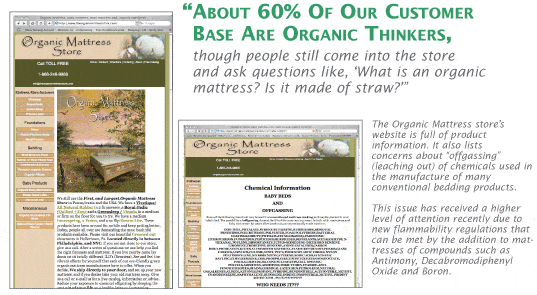
“We’re targeting people already thinking about their personal health and the changing climate. A really good quality mattress can last 20 to 25 years. And, if after that length of time, people should choose to throw it into a landfill, it’s gratifying to know that in the end it’s actually biodegradable!
“Just this past January, I developed and introduced my own line of Peruvian organic cotton sheets. Bergman, the parent company, is Swedish, and the cotton is from Peru. They’re going very well. And we carry wool carpeting. The under padding is also wool. Again, thinking sustainability, down the years awhile, both the carpet and padding can be used in the garden for walking rows. It will degrade. Even the carpet packing is made of natural jute and it will also degrade.”
The Hornicks are advertising in Delicious Living, Natural Home and Garden Magazine, Yoga Magazine and, of course, 21st century Google!
Their demographic is 25 to 60, environmentally friendly people with “better than average educations. The concept has been accepted very rapidly and about 60 percent of our customer base are ‘organic thinkers’. We do use direct mail in the form of postcards, but we do much, much better on the Internet.” Speaking of which, have a look at their website, www.theorganicmattressstore.com.
“We keep a customer list and e-mail everyone when we have something special to tell them about, like the opening of our new store!” The original store was about a thousand square feet and they expanded in their move to fifteen hundred square feet, “as well as some storage area so we can keep more product on hand. We’ve done a lot of the work ourselves, sweat equity! Really helps you to take ownership of the place. We’ve used textured natural clay plaster on the walls in a really vibrant earth tone red. The organic carpeting is in milk chocolate brown and the woodwork is natural finished pine.”
They are much involved in the community. They are members of the Sustainable Business Network of the Lehigh Valley. At their last grand opening they gave 25 percent of sales to Kid’s Peace, a local children’s shelter. And they donate to baseball teams, walks and other such events in the area.
“We feel very optimistic. Everything that’s happening, the Al Gore’s of this world, everyone reading and hearing about the environment and beginning to do something about it. The consumer can’t help but become more aware every day.”
Custom Comfort Mattress
Back on the West Coast, in Orange County, California, Custom Comfort Mattress Company, a chain of six stores with a factory/headquarters base, is making a very positive mark on the environmental scene. Custom Comfort has a well-merited 25th anniversary on its corporate horizon.
Maroun Nehme is Director of Sales and has been on staff for nine and one-half interesting and stimulating years. “I began by delivering beds and mattresses, everyone does, working their way up from the bottom in the traditional manner. That’s great because then you know and understand everything that’s happening in the company.”
Custom Comfort was founded by three brothers, Mel, Gary and Marty Trudell (Marty is now retired), and has more than 100 employees. “Our aim is to be the Nordstrom of the furniture industry or perhaps Chick-fil-A, a really successful chain of quality fast food outlets. Their philosophy has remained unchanged for more than 100 years, ‘to offer the customer the best possible service, selection, quality and value’, and their vision is to ‘serve a higher calling’ and much of their community outreach involves working with children. A combination of both!”
Custom Comfort already sponsors school programmes particularly in athletics, and they stage school tours regularly that “the kids love”.
And, like Nordstrom, their approach to service is exemplary. “Creating a customer is a lot more valuable than creating a sale,” said Maroun. “We have customers who bought mattresses for their whole house plus boats and RVs 15 years ago, and they are returning now to buy new.
“It does happen very occasionally that a customer will pick out the wrong bed. Since we are a factory as well as a store, we are able to make adjustments to our mattresses and keep the customer very satisfied.
“When they come to shop with us at any of our locations we make their visit as pleasant as possible, even to opening doors and helping them carry pillows, bedding and so forth to their cars. None of our people are on commission, very important.
“We keep a sparkling clean kids’ area in each of the stores, stocked with toys and simple books to keep them happy while their parents shop.”
Right from the get go, Custom Comfort has built “quality mattresses, good natural materials, in the old fashioned way. They are built to last. We want people to come in and try our mattresses, touch, feel, and lie down on them, take a little time. It is, after all, in their best interests. We also manufacture pillows, sheets and headboards.”
Orange County tends to lead a lot of market trends. “The majority of our customers are between 40 and 55, affluent with an annual income average of around $94,000. There’s a lot of self-awareness, and the safety of their children is important to them. They are boomers, looking for a better way to live.
“Our Governor, Arnold Schwarzenegger, is definitely pushing everything green and that’s creating awareness and helping to expand the market for environmentally friendly product lines. A lot of young people are coming into our stores, some of whom have allergies and want to be sure they are getting natural, organic products. All in all, it’s the wave of today and the future.
“We joined forces with Organic Mattresses Inc. a year ago and we’re working hand in hand. They’re almost like a sister company to us. They manufacture a quality organic line, from king size to crib size, at their absolutely spotless, environmentally pristine facility.
It’s the only Certified organic mattress manufacturing facility in North America. We are their exclusive dealers here.
“In the production process, they use only purified compressed air. Their forklifts are electrical and are equipped with white wheels. There are absolutely no synthetic raw materials ever used that could contaminate products. All of their natural materials are grown and processed without toxic chemicals, of 100 percent natural rubber latex, cruelty free, flame resistant Eco Wool from free grazed California sheep and certified organic cotton, all renewable, biodegradable resources.
“OM, Inc. recently received the coveted Greenguard certification, granted only to those products that meet their low VOC emission standards. Certified for Children and Schools, this is GREENGUARD’s most stringent certification.
Maroun has “some impact on marketing” and, Mel “contributes to the process”. Not long ago they “added a staff member who devotes full time to marketing”. Their approach, as you might expect, is a tad different. Word of mouth has been vital to the growth of Custom Comfort, Maroun told us. “We advertise in Whole Life Magazine, also Coastal Living Magazine, both our own natural line and OM, Inc. products. We also use two major newspapers, The Los Angeles Times and the Orange County Register, and other local papers. We have done television infomercials. And we are involved in lots of radio talk shows and Christian stations, the more conservative stations.
“But back to word of mouth. A referral can begin as simply as people chatting while they’re standing in line at the movies, someone that had been looking for a mattress, who came to us and just loved the product. An eavesdropper overhears, visits one of our stores, then she/he tells people about us. It’s really huge!”
Some of their radio talk show contacts are also their customers. When you visit Custom Comforts website, www.customcomfortmattress.com, you’ll discover comments from Programme Host Ted Ziegenbusch, KFSH 95.9 FM, Frank Pastore and Warren Duffy, Talk Show Hosts from KKLA 99.5 FM and Hugh Hewitt, Talk Show Host, KRLA 870 AM, all glowing. And some really great stories from other folk, pleased with their shopping and sleeping experiences!
Concerts held cooperatively with KFSH have been very productive. “We put up a tent, make seat cushions with our name on them that people can take home. And we make bags from surplus mattress materials, also with our name on them. Good exposure and community outreach.”
Maroun pointed out that so-called organic products coming in from abroad have to be fumigated before they can enter the United States. He says that this process negates any natural organic value they had at their point of origin.
Another marketing tool is signage in the windows of all six stores and also interior directional posters.
The future of Custom Comfort? Maroun radiates confidence. “We will be expanding into other areas in Southern California. The trends show more and more interest in things organic. Our baby products line, just introduced, is growing very well.” The sky’s the limit!
Safe. Sustainable. Environmentally friendly. A symbiosis of concepts, people, nature and action. A better world all ‘round, hopefully coming sooner than we think!
The Greening Of Polyurethane Foam
In addition to natural latex harvested from rubber trees used in some of the organic bedding mentioned earlier in this article, environmentally friendly polyurethane foams have been making their debut in retail furniture showrooms. Even more of these furniture grade polyurethane foams, traditionally made exclusively from petrochemical sources will be undergoing a “green” transformation in the coming months.
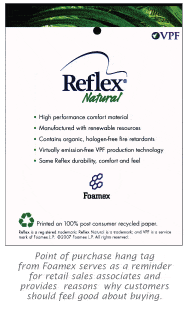
As we discussed in the March/April and May/June issues of FURNITURE WORLD Magazine (see the article archives on www.furninfo.com), a small but growing number of furniture manufacturers, retailers, and consumers are looking for home furnishings that are healthier to use, sustainably sourced and responsibly produced. Certainly all things being equal, most consumers would rather buy products that are kinder to the environment and their families.
Steve Hassall, Director of Marketing, Foam Products Group, Foamex International, the producer of Reflex® Natural™, “a high-performance, environmentally-friendly flexible polyurethane foam for the furniture industry” noted in a recent interview that most consumers are not yet willing to sacrifice style, durability, or competitive price to “go green”, but given the choice of upholstery or bedding with similar attributes, they will feel good about making an environmentally conscious choice. He said that he agrees with a furniture buyer for a major retail chain, who told him, “that while many people feel varying degrees of responsibility for supporting environmental sustainability, it is truly a core value of today’s younger consumer demographic. Core values and purchasing power can combine to drive the market for ‘green’ products, and a more sustainable future.
“At Foamex,” he continued, “we use our technology and R&D expertise as a platform to consistently innovate new products. There are a number of reasons to leverage our expertise in the market, but as part of our stewardship role, we believe that the most important reason is that it simply is the right thing to do.”
Getting good information about the true environmental impact of a finished furniture item or the raw materials used in its manufacture can be daunting. In the case of polyurethane foams, increasing the percentage of NOPs (natural oil polyols) from plants (a renewable resource) is a good start. The plant material must, however, be sourced, converted NOPs and then manufactured into finished foam. The manufacturing technologies used to convert the vegetable materials to foam vary in their level of energy use and contaminant by-product release to air, water and land.
Another consideration for retailers who are interested in selling healthy products to their customers is that polyurethane foams must conform to state and federal flammability regulations, notably California Bureau of Home Furnishings Technical Bulletin 117 requirements for bedding and voluntary UFAC smoldering ignition resistance criteria. If you are one of these retailers, you may want to obtain information that can be disclosed to interested customers on the nature of chemicals used to meet state and federal mandates.
Dr. Erin O’Driscoll, the development manager for Dow Polyurethanes, a business within The Dow Chemical Company, says that with some of the existing NOP technologies, getting a much higher “green” content has presented technical challenges. For example, higher levels of NOPs can sometimes negatively affect the tensile strength, resiliency and compression set, or in layman’s terms, the durability, feel and comfort of the foam. And, in many cases, increased NOP levels result in strong and unpleasant odors, not exactly a consumer-friendly feature.
Dow scientists, Dr. O’Driscoll noted, are now able to produce odor-free polyurethane foams that contain much higher percentages of NOPs – up to 60 percent. “Environmentally-conscious consumers will be happy to learn,” she said, “that these products are greenhouse-gas neutral and require 60 percent fewer fossil fuels than traditional polyols, based on a ‘life-cycle analysis’ which measures a product’s impact on the environment over its lifetime.”
She gave the following advice to FURNITURE WORLD Magazine’s readers interested in incorporating “sustainable” polyurethane foam into their furniture lines:
- Look for odorless polyurethane foam with a high natural oil polyol content.
- Ask your supplier for a life-cycle analysis to determine the eco-friendliness of the product.
- Test the foam prior to purchasing to make sure it meets the performance standards for your particular end use.
One Final Note...
As the concept of sustainability catches on, marketing can and probably will eclipse ethics in some manufacturing and retail organizations. That is only “natural”! For example, sustainable products, natural products and products derived from organic sources are very different things, though each can be used to mislead. For example:
•Petrochemicals (fossil fuels and derivatives) are organic compounds (derived from living things).
•Natural materials can, and often are, sourced produced and marketed unsustainably.
If you are concerned about the quality of the information you pass on to your customers, some research will be required.
RUGMARK FOUNDATION
Another shade of green!
For thousands of years, some of the world’s most treasured rugs have been created in India, Pakistan and Nepal. Hand woven or knotted from silks and wools, they have been put to use for prayer, aesthetic appeal and comfort. And, according to whimsical legend, as a means of transport, magical flying carpets soaring between moonlit minarets and the peaks of the Himalayas!
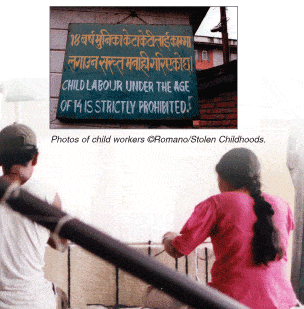
But while we savor their luxury and elegance, we now know that small children have been forced to work long hours at the looms, jeopardizing their education and their health.
Established in 1994, RugMark is working to end exploitive child labor in the carpet industry in South Asia through loom and factory monitoring, consumer labeling, and by offering education to former child weavers. The number of children enslaved on the looms has dropped from one million to 300,000 over the past decade. The RugMark message and logo can be seen and heard in six countries now, the United States, the United Kingdom, Germany and, of course, India, Nepal and Pakistan.
Jaya Bhandari and Sanita Lama, two former child carpet weavers from Kathmandu, were rescued by RugMark inspectors when they were eleven and ten respectively. They were placed in one of RugMark’s community-based rehabilitation centres, and later in school. Today, both now 19, they are high school graduates working to help other children reclaim their childhood.
This spring, the teenagers toured four cities in the U.S., Boston, New York, Washington, DC and Miami. The purpose, “to allow hundreds of people to come face-to-face with an otherwise anonymous issue,” said Nina Smith, Executive Director, RugMark Foundation U.S.A. “The gulf between children working illegally on carpet looms in South Asia and many of our own children here in the States is extreme and practically impossible to overcome. In some small way, this tour will help close the gap and build understanding.”
The tour coincided with the twelfth anniversary of the murder of Iqbal Masih, an indentured carpet weaver who ultimately became the spokesperson of the child labor movement. His devotion to the struggle of other child slaves after his own six years of grueling labor, made him a hero in the global human rights community. Jaya and Sanita will continue to carry the community’s message, helping to influence the U.S. market to demand child-labor-free rugs.
RugMark recently launched The Most Beautiful Rug, a national consumer awareness campaign designed to reduce and ultimately eliminate illegal child labor in the handmade rug industry. The campaign goal is to increase the market share of RugMark certified rugs from one percent to seven percent over three years.
The certification programme is integral to RugMark’s mission. It recruits carpet producers in India, Nepal and Pakistan to make rugs free of illegal child labor and recruits importers in Europe and North America to sell their child labor-free rugs. By agreeing to adhere to RugMark’s strict no-child-labor guidelines and by permitting random inspections of carpet looms, manufacturers receive the right to put the RugMark label on their carpets. The label offers the best possible assurance that children were not employed in the making of a rug. It also verifies that a portion of the carpet price is contributed to the rehabilitation and education of former child weavers.
RugMark’s ultimate aim is to achieve 15 percent market share by 2012 which, according their estimates, is the tipping point to completely eliminate child labor from South Asia’s handmade rug industry. Over this period, every gained percentage point in market share will equate to a projected 750 children rescued from the workplace and one thousand more who will be saved from entering the industry.
RugMark is an international nonprofit organization. For more information and a list of importers and retailers that sell RugMark certified rugs, visit www.rugmark.org.